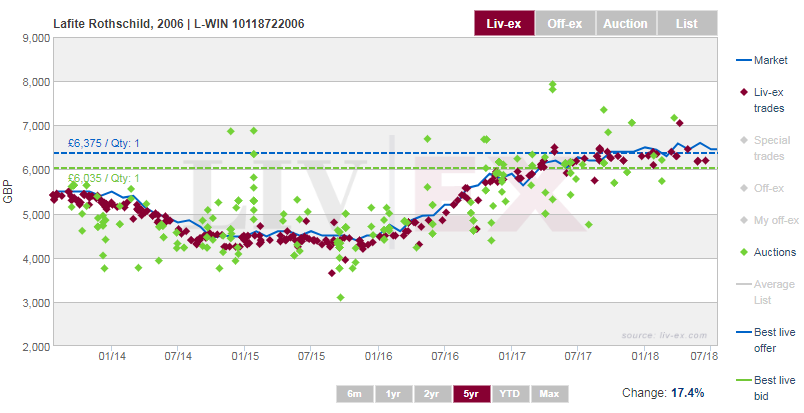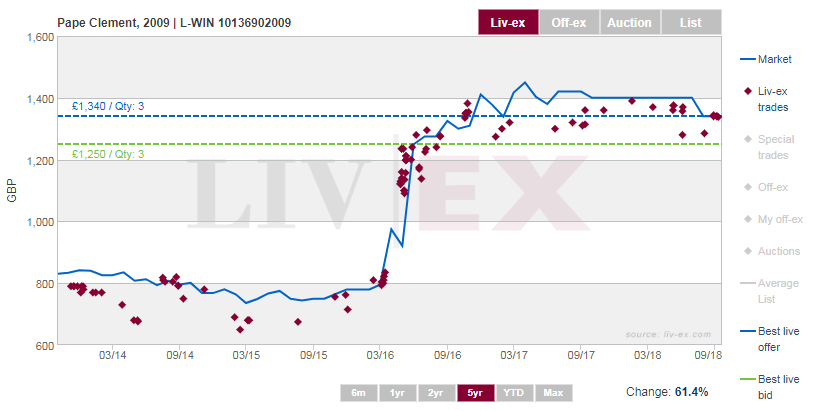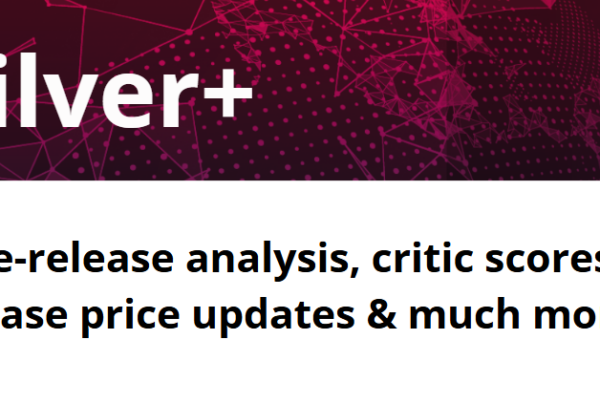A version of this article was written by Liv-ex Marketing Manager Sarah Phillips for WSET Diploma graduates in July. A more beautifully formatted version of the report is available on the WSET Alumni Global Campus for diploma graduates.
Background
A 2012 survey by Barclays Wealth and Investment Management found that 28% of high net worth individuals have a wine collection, and that 2% of their wealth is tied up in wine. This is no new phenomenon: In various forms, wine trading and collecting has taken place for centuries. The ancient Greeks, Egyptians, Phoenicians and Romans were all big traders of wine; Charles II of England famously had Haut Brion in his cellar.
The idea that wine improves with age dates back to the 18th century. A series of innovations made extended ageing possible: Sulfur had been introduced as a preservative, corks had become available to use as stoppers and finally, in 1775, the production of bottles was standardised so that they could lay flat. Courtiers in Bordeaux began to make distinctions between wines suitable for ageing (“sèveux”) and those for immediate consumption (“moins longue garde”).
The writings of Thomas Jefferson provide perhaps the first evidence of a premium charged for older wine. In 1787, he wrote that the 1786 vintage for top Bordeaux wines cost 1800 livres per tonneau compared to 2000 livres for the older 1783.
By the 19th century, wine – particularly Port, Madeira and Bordeaux – had become popular vehicles for speculation in Britain. The story of the merchant Herman Cruse offers one dramatic example. He bought 90% of the entire Bordeaux crop in 1847 at a deep discount. Revolution was threatening to destabilise Europe at the time, and nobody else was interested in it. When revolution never materialised, he sold up, accruing a vast fortune.
Development of a marketplace
By the beginning of the 21st century, the practice of speculating on investment-grade wine was well established but somewhat fragmented. There were still no standard trading rules and information sharing among merchants – particularly around price – was poor. It was possible to check auction prices, but they were not standardised for condition or tax status.
At this point, the rise of the internet presented the opportunity to create a marketplace that would ultimately bring greater transparency, efficiency and safety. In 2000, Liv-ex was established with this ambition in mind.
The introduction of standard trading contracts was one of the first steps taken to support this goal. Contracts give traders confidence that the wine will arrive in the expected condition, and enable like-for-like price comparisons. The most-used contract, Standard-In-Bond (SIB), stipulates condition, tax status and delivery time.
Today, over 400 merchant members around the world use Liv-ex to check prices, spot opportunities and match and settle trades. Its membership represents the largest group of fine wine merchants worldwide.
This chart of Lafite Rothschild 2006 illustrated this point well. The red dots are trades of standard stock on Liv-ex. They track the market price efficiently. The green dots are for stock sold at auction. The condition and status of the stock is not standardised, making like-for-like comparisons impossible.
Investing in fine wine
Academic research estimates that fine wine has offered a 4.1% return on investment in real terms between 1900 and 2012, outperforming other alternative assets such as art and stamps.[1] Historically, it has shown a very low correlation to mainstream assets, making it a useful portfolio diversifier. When equities suffer during a recession, fine wine can often prove resilient.
Accessing the market
Liv-ex is only available to professional wine buyers and sellers. Private collectors wishing to invest in wine can access the market via one of two routes.
The first, and most common, is to purchase cases through a reputable wine merchant. The collector becomes the owner of specific cases or bottles of wine and can watch them increase – hopefully – in value until he or she is either ready to drink or sell them.
Merchants will typically charge a fee of around 10% to sell the wine. Because the asset will need to rise by more than this before the collector profits, wine is considered a long-term investment, rather than something than can be day traded.
The second route is to invest in a wine fund. In this instance, the investor owns a percentage of a portfolio of wine, rather than any individual cases, which is managed by an investment fund.
Finding the right information
Today, information about the quality and price of fine wine is widely available.
Indices
Liv-ex has developed several fine wine indices. The Liv-ex 100 Index, which features on the Bloomberg terminal, is considered the industry benchmark. It tracks prices of the world’s leading fine wines. Uniquely, these are calculated using transactional data from Liv-ex.

Prices
It is now possible for collectors to receive independent valuations of wine that they seek to buy or sell. Liv-ex collects and verifies prices from its merchant members, and trading activity on the marketplace, in order to provide accurate valuation information.
Critics
Many collectors and traders consider critic scores vital in informing buying and selling decisions. Historically, the American critic Robert Parker, founder of The Wine Advocate, yielded the greatest influence over the price of wine.
Parker’s power was such that a score ‘upgrade’ for a wine could result in rapidly rising prices. Since his retirement in 2016, several other critics have become increasingly powerful in the fine wine investment world but none possess Parker’s former power. Important names for Bordeaux include Neal Martin and Antonio Galloni of Vinous, James Suckling of Jamessuckling.com, Lisa Perotti-Brown MW of The Wine Advocate, James Molesworth of Wine Spectator, Jane Anson of Decanter and Jancis Robinson of Jancisrobinson.com, among others.
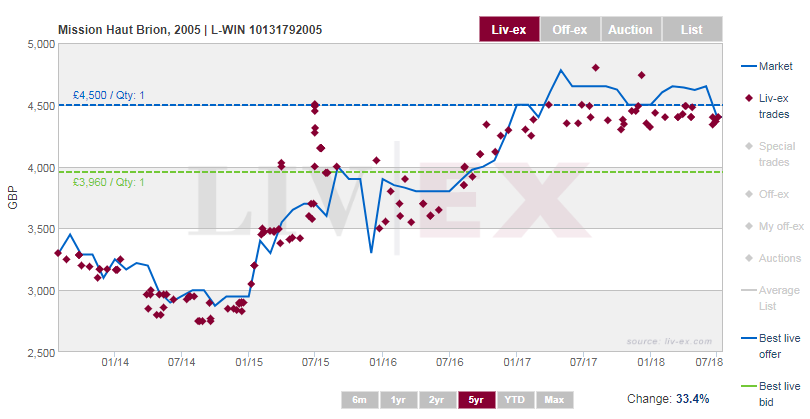
Mission Haut Brion 2005 was a beneficiary of Parker’s 2005 ‘ten years on’ report. It was upgraded from 98+ to 100 point in 2015. Parker had hinted at an upgrade back in August 2012. With buyers anticipating a bigger score, its price began to creep up at the beginning of 2015. Between January and June 2015, when the score was revealed, its trade price moved from £3,200 to £4,506 – a staggering 47.7% increase.
In March 2016, Pape Clement 2009 was trading on Liv-ex at £835 per 12 x 75cl case. Following an unexpected upgrade to 100pts from Robert Parker a month later, its price moved up to £1,130 – a 35% change.
Recent market trends and the current picture
Fine wine, like all markets, experiences cycles. During World War Two, prices rose by 600% while Germany occupied France. They then collapsed by 50% when the war was over. Similar cycles were witnessed in the 70s, 80s, 90s and more recently from 2009-13.
Fine wine prices have shifted several times over the past 15 years. The industry benchmark Liv-ex 100 dipped 20% during the financial crisis, before climbing 70% by mid-2011 largely owing to the huge fiscal stimulus in China from 2009. Prices then fell from 2011 as buying in the Far East almost came to a halt. Weakened sterling contributed to a “Brexit” boost to the market from mid-2016.
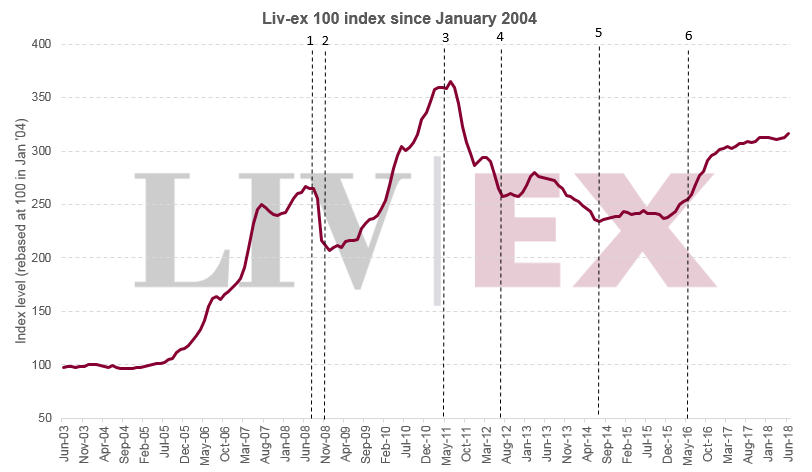
1. September 2008 – Lehman Brothers file for bankruptcy, signalling the start of the financial crisis
2. November 2008 – China announces economic stimulus programs: 4 trillion yuan of investments in areas such as infrastructure, transport, industry, tax cuts and finance. Chinese interest in fine wine, a popular gift among officials, steadily increases.
3. May 2011 – The Bordeaux 2010 vintage is offered for sale at record prices, testing the strength of the market
4. July 2012 – China announces a crack-down on gift-giving of luxury goods among government officials
5. July 2014 – The market hits its lowest point since before the China-led boom
6. June 2016 – Sterling weakens following the UK’s ‘Brexit’ vote. This provides a boost to the market as stock held in the UK is effectively discounted to overseas buyers
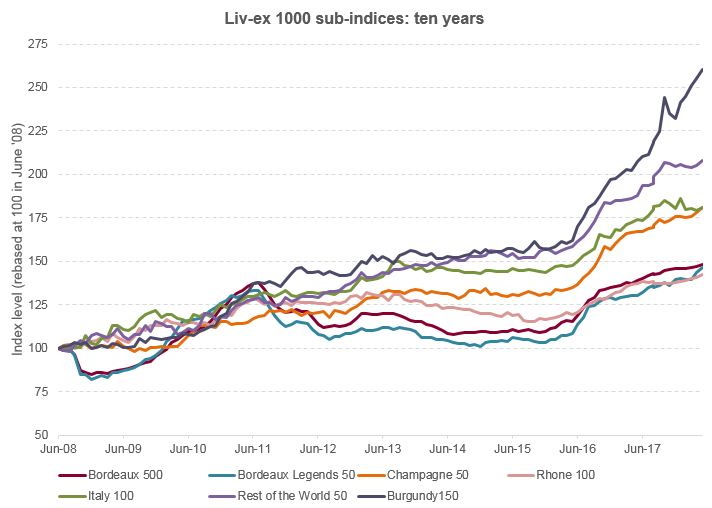
The performances of wines from different regions are far from uniform. Over the past decade, insatiable demand for Burgundy has driven prices for the top wines into the stratosphere. The Burgundy 150 index is up 160% over this period. In contrast, wines from the Rhone have lagged.
Another major trend is the considerable broadening of wines that trade actively on the secondary market, i.e. those that are bought and sold more than once, and often several times throughout their lifetimes. Ten years ago, activity on the market was dominated by a narrow group of top Bordeaux wines. The market has broadened considerably since then, as the chart below shows.
Bordeaux’s trade share is down from 95% in 2010 to 61% so far in 2018. Wines from Burgundy, Tuscany, Champagne and the USA now trade actively, among others. In 2016, Liv-ex even saw its first trade for English and Chinese wines when Nyetimber and Ao Yun traded.
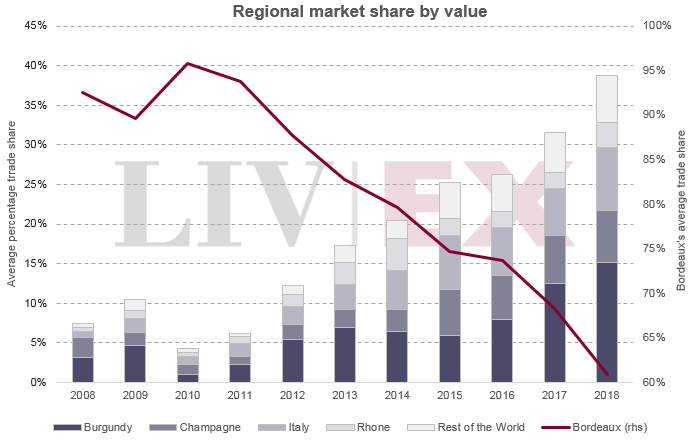
Power 100
The Power 100 lists the most powerful fine wine brands in the secondary market. Although top Bordeaux Chateaux continue to dominate, the latest list, published in December 2017, reflects the rising power of the Burgundy brands and those from around the world. You can view it here.
The 2018 list is due to be released this December.
Liv-ex Classification
Every two years, Liv-ex produces a classification of Bordeaux wines. Like the original classification of 1855, it places fine wines into five classes solely based on price. In 2017, wines from the rest of the world were included to create a global classification for the first time.
You can find the 2017 list here. The next rankings are due in summer 2019.
Future developments
In recent years, Liv-ex and the merchant community have been working together to take advantage of opportunities presented by new developments in technology.
LWIN – unique seven-digit codes – has underpinned much of this progress by introducing a simple and consistent naming convention for fine wines, similar to the ISBN for books. LWIN is free for anyone to use, and has been adopted by major merchants, logistics suppliers and critics to facilitate the automatic exchange of information on fine wine.
With LWIN working hard in the background, merchants can now produce valuation reports for customers in minutes. Wine Matcher, a browser-based tool which cleans and prices lists of wines at a rate of 5,000 lines of data per minute, makes this possible. These valuations help to provide informed buying and selling decisions.
Trading is also becoming more connected. Merchants around the world are now connecting to the market using DMA, Direct Market Access. It allows them to automatically offer their stock list on Liv-ex, and also offer stock from the global trade on their ecommerce website.
Effectively, a wine merchant in France could list his or her available stock on Liv-ex in real-time. A customer in the USA might browse his or her local merchant website, which automatically displays these wines, and make a purchase. The whole trade is settled automatically, and the physical stock moves through Liv-ex’s transport network. This is an exciting prospect for the global distribution of wine, particularly with the market for fine wine broadening.
The Wine & Spirit Education Trust (WSET) is the largest global provider of qualifications in the field of wine, spirits and sake. Qualifications are offered at a range of levels for both professionals and enthusiasts through over 800 Approved Programme Providers worldwide in over 15 languages. For more information or to find a local Approved Programme Provider, visit wsetglobal.com.
*Many of the historical references in this article were sourced from the excellent “What Price Bordeaux” by Benjamin Lewin MW.
[mc4wp_form id=”18204″]

